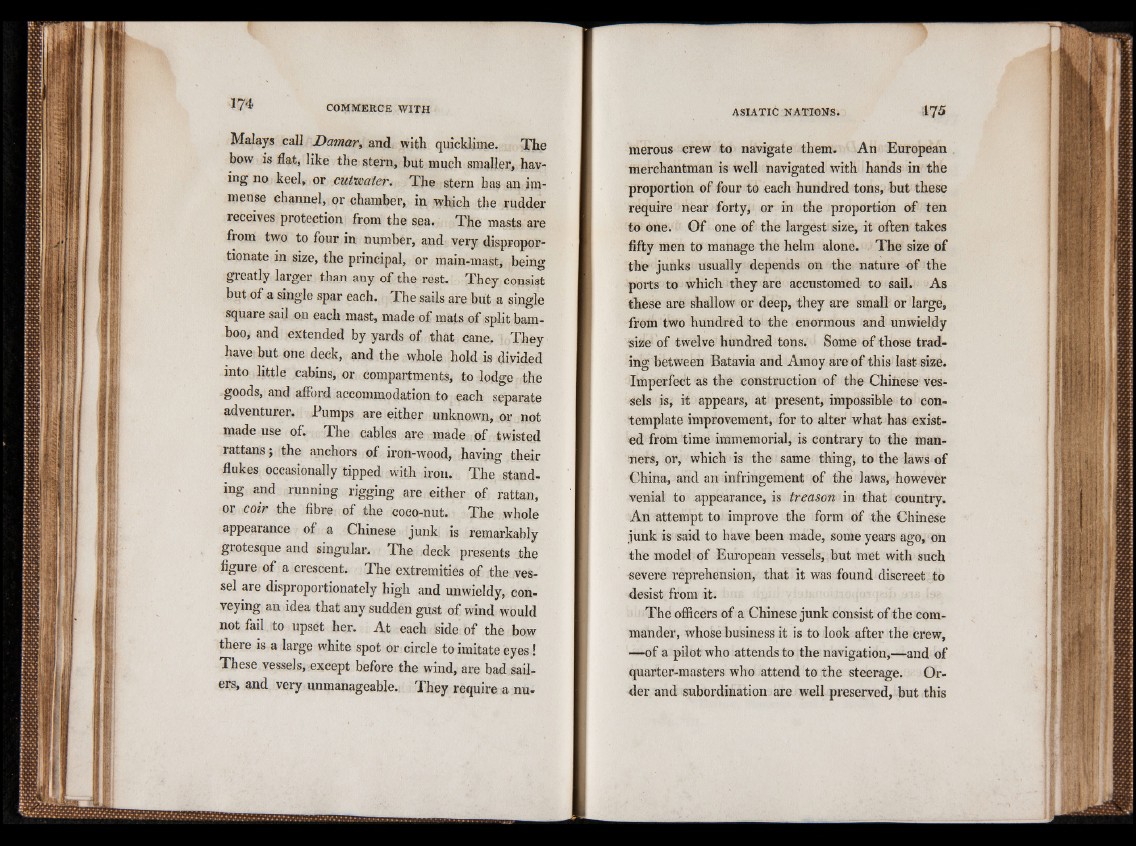
Malays call Damar, and with quicklime. The
bow is flat, like the stern, but much smaller, having
no keel, or cutwater. The stern has an immense
channel, or chamber, in which the rudder
receives protection from the sea. The masts are
from two to four in number, and very disproportionate
in size, the principal, or main-mast, being
greatly larger than any of the rest. They consist
but of a single spar each. The sails are but a single
square sail on each mast, made of mats of split bamboo,
and extended by yards of that cane. They
have but one deck, and the whole hold is divided
into little cabins, or compartments, to lodge the
goods, and afford accommodation to each separate
adventurer. Pumps are either unknown, or not
made use of. The cables are made of twisted
rattans 5 the anchors of iron-wood, having their
flukes occasionally tipped with iron. The standing
and running rigging are either of rattan,
or coir the fibre of the coco-nut. The whole
appearance of a Chinese junk is remarkably
grotesque and singular. The deck presents the
figure of a crescent. The extremities of the vessel
are disproportionately high and unwieldy, conveying
an idea that any sudden gust of wind would
not fail to upset her. At each side of the bow
there is a large white spot or circle to imitate eyes!
These vessels, except before the wind, are bad sailers,
and very unmanageable. They require a numerous
crew to navigate them. An European
merchantman is well navigated with hands in the
proportion of four to each hundred tons, but these
require near forty, or in the proportion of ten
to one. Of one of the largest size, it often takes
fifty men to manage the helm alone. The size of
the junks usually depends on the nature of the
ports to which they are accustomed to sail. As
these are shallow or deep, they are small or large,
from two hundred to the enormous and unwieldy
size of twelve hundred tons. Some of those trading
between Batavia and Amoy are of this last size.
Imperfect as the construction of the Chinese vessels
is, it appears, at present, impossible to contemplate
improvement, for to alter what has existed
from time immemorial, is contrary to the manners,
or, which is the same thing, to the laws of
China, and an infringement of the laws, however
venial to appearance, is treason in that country.
An attempt to improve the form of the Chinese
junk is said to have been made, some years ago, on
the model of European vessels, but met with such
severe reprehension, that it was found discreet to
desist from it.
The officers of a Chinese junk consist of the commander,
whose business it is to look after the crew,
—of a pilot who attends to the navigation,—and of
quarter-masters who attend to the steerage. Order
and subordination are well preserved, but this